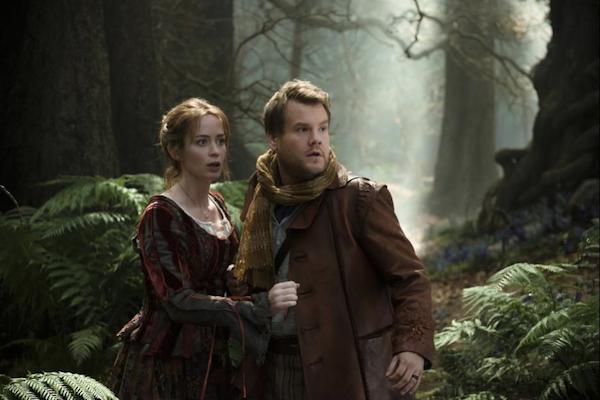'Into the Woods' Is A Fairytale Best Told On Stage Or On Screen?

Disney’s adaptation of Stephen Sondheim’s “Into the Woods” could have gone very badly. But it didn't. Instead, the film proves that a healthy dialogue can exist between the theatre and the cinema, leaving even the experts of each medium with something to learn.
A great adaptation from one art form to another can be made if those who make it are able to preserve the integrity of the original work while adding elements unique to the medium in which they are working. In other words, what makes “Into the Woods” so successful is that the original text is treated with respect, but director Rob Marshall knows how to take advantage of the story in film form.
“Into the Woods” is a composite story, following various storybook characters until their seemingly separate stories converge into a single narrative. The advantage of the stage is that all of these stories can be seen simultaneously. The film accepts its inability to follow suit, and instead chooses to focus on each individual story, one at a time, while continuing the highlight the parallels underlying the action.
Moviegoers understand that Little Red brings treats to her grandmother’s house while at the same time Cinderella’s cruel stepsisters deny her attendance to the ball, but the individual each receive their own “place” in cinematic time and space.
SEE ALSO: 'Into the Woods' Has A Spellbinding Reunion
The titular location of the story, the woods, is naturally treated differently in theatre than in film. Creating a forest onstage requires a great deal of imagination and theatrical convention, while the cinematic iteration is far more literal. The world of the story is its own reason for a Broadway aficionado to see the film, while the woods in the movie offer a very different experience as an impressive, immersive spectacle.
The cinematic interpretation of the woods does much of the work that was formally expected of audience members, providing perfectly packaged visual sources of awe. A great deal of detail and immersion is gained, in return for the lost magic of theatrical localization.
The film remains true to the show’s original intent and is able to be such a just translation largely because key figures of the creative team of the original musical are collaborators on the film. Sondheim, the original musical composer, was very involved in the script drafting process and approved all changes to the plot; and the screenplay was written by James Lapine, who wrote co-wrote the original show with Sondheim and directed the original Broadway production. Paul Gemignani was the conductor and supervisor for the music, and was also the music director for the original Broadway run. Because of this heavy involvement from the original creative team, the film remains much of its original authenticity concerning plot and message.
SEE ALSO: Film Review: 'Into The Woods'
Despite the overall closeness of the adaptation, there were some significant plot changes.
For one thing, The Narrator’s character was entirely cut because his role in the show wouldn’t have translated clearly into film. In the stage production, he provides a great deal of visual detail and narrative backbone to the different stories that aren’t necessary in the film. But because the screenplay cut him out, some important moments from the stage production are lost, such as when he ceases to be a standard narrator and actually begins to interact with the other characters onstage.

Additionally, the film great reduced the role of the Mysterious Man, who we later find out is also the Baker’s father. In the film, the Baker briefly sees his father as a hallucination to prompt him to be a better father. In the stage version, rather than being a mental construct, the Mysterious Man is a literal character and shares a touching song with his son, “No More.” Without this moment, some of the emotional impact if lost from the Baker’s decision to stay with his newborn child and be better than his own father.
SEE ALSO: 'Into The Woods,' And Out Again, With...Something
The University of Southern California offers the opportunity for those who saw the film to catch what they missed from the stage production in Musical Theatre Repertory’s upcoming production of “Into the Woods.”
MTR, a student-run theatre company, typically puts on three musicals each academic year, and their winter production is a great way for fans of the story to see “Into the Woods” back-to-back in two very different presentations. The timing of the production allows for an exercise in comparing artistic interpretations and adaptations, giving audiences a sense of what both the mediums of film and theatre are uniquely capable of.
“In MTR’s production, the audience has the ability to really connect to our actors because it’s in a black box theatre and in such an intimate setting,” says Jessica Major, the stage manager of the production. The proximity makes the production similar to film, she claims, except “you don’t lose anything on the stage like you do on camera,” particularly with the divergent, simultaneous narratives.
Although the movie “very much stayed true to the original stage production,” according to Taubert Nadalini, the Assistant Director, he believes that “MTR will be performing the full show with gusto, and I think audiences in the Massman will be thrilled to see all the quirks and dark innuendo that Sondheim and Lapine originally infused into their story.”
Although Disney’s film adaptation of “Into the Woods” was largely successful, it isn’t the full story, and while it may triumph on its own merits as a film there is still a great deal to be offered in a theatrical production.
Not all fervent theatergoers may be satisfied with the film, but Allison Aoun, director of the upcoming MTR production, insists, “No matter the good or bad, I think it’s important for people to see the film… There used to be so many movie musicals and the change in audience desires and the expense of making them caused them to be a rarity.” If the film inspires audiences with a love of musical storytelling, and can get people out to the theatre to see productions like MTR’s, then its success will transcend the success of any individual interpretation and will be a great benefit to the musical theatre community worldwide.
Musical Theatre Repertory's production of "Into the Woods" runs January 22-25 in the Massman Theatre (1029 Child's Way, Los Angeles). There is a suggested $5 at the door. For tickets and specific show times, please visit www.uscmtr.com.
Contact Staff Reporter Ryan David McRee here.



